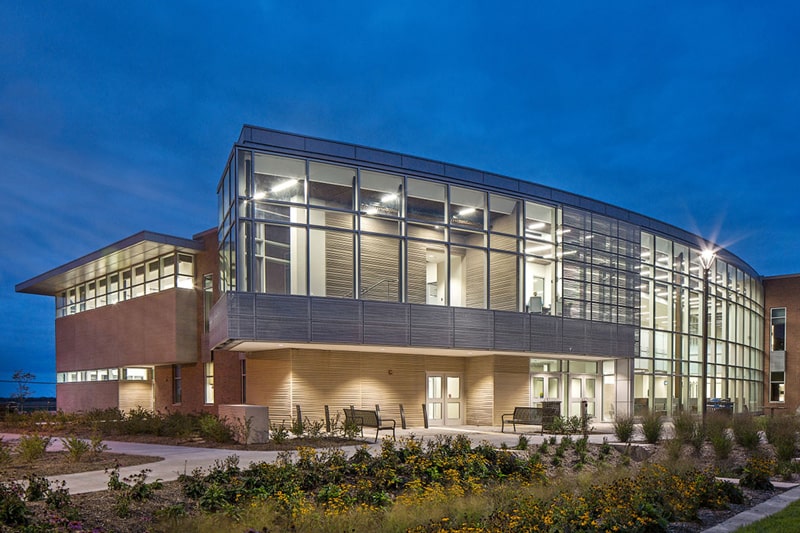up next Nikki Carritt
Defining the Future of Rural Healthcare
By Jackie Ostrowicki
February 2022
Today is a busy day for Dr. Cade Craig, one of three primary care physicians at the Minden Medical Clinic. He is seeing patients at the clinic, then performing a colonoscopy and ending the work day by checking in on a patient in the hospital. His brother, Andy, who is also a physician at the clinic, will spend some time in the emergency room. When the work day is done, both brothers will turn their attention from patients to the community—Andy will attend a school board meeting and Cade will stop by a Minden Chamber of Commerce event.

Minden—the county seat for Kearney County—has a population just under 3,000. The Craig brothers grew up there, attended UNK, went on to UNMC’s College of Medicine, and returned to Minden to practice family medicine. Practicing family medicine in a rural area is appealing for someone who wants a broader scope of practice.
“We see all types of patients with all types of conditions,” said Cade Craig. “It brings a lot of variety to the practice of family medicine. This can be challenging, but it’s also very rewarding.”
Rural Nebraska’s Urgent Health Care Needs
Rural health care has its own needs, specific to the communities it serves. Some are related to agriculture-specific workplace injuries and exposures. But the rural landscape is changing—and so are its demographics.
"Rural healthcare providers have always had to be flexible, stretch resources, and innovate."
Patients are often older, and many have chronic issues that need to be addressed. There are cultural differences that a broader range of ethnicities brings to health care practice. When students train in areas experiencing these changes, it helps them to provide better care when they begin to practice.
UNMC formed the Office of Rural Health Initiatives in 2019, dedicating resources to address the pressing needs of rural Nebraska. Nikki Carritt is the director of the office. She was raised on a farm in Pisgah, Iowa, a town of 200 people, and still lives in a rural area. To Carritt, furthering rural health is not just a job—it’s a passion that helps her meet the needs of the families and communities she knows so well.
Shortages affect every health care profession. Clinics and hospitals confirm challenges in hiring staff to provide care to Nebraskans.
“Services are not as widely available in rural areas, which can impact access to quality care. You don’t have specialists around every corner or 15 pharmacies you can choose from,” said Carritt. “There may be one primary care physician who serves an entire county.”
Ongoing shortages in the health care workforce exist across rural Nebraska. Fourteen of the state’s 93 counties do not have a primary care physician. Shortages affect every health care profession, and clinics and hospitals confirm challenges in hiring staff to provide care to the residents of this state. These shortages limit the health care that rural Nebraskans can access, and they impact the ability of communities to attract new residents and businesses.

Serving As a Health Care Training Hub for Rural Nebraska
The Health Science Education Complex on the University of Nebraska at Kearney’s campus was built in 2015 to provide opportunities to expand enrollment in health care majors. The programs housed at the complex filled up to capacity quickly, and more programs such as occupational therapy were added. UNMC also saw an increase in graduates working in rural Nebraska—about 85 percent of students who graduate from the program start their careers in Nebraska.
Carritt noted that one of the important pieces of the Health Science Education Complex’s success is location. “Kearney provides a great opportunity to serve as a hub to the central and western regions of our state,” she said. “Students can do training and service learning from Norfolk to Scottsbluff, based in a centralized location.”
The Health Science Education Complex uses a place-based approach to training health care professionals. Rurally located and focused, it places students in rotations in small communities where they work together as part of a team. It trains them in rural-specific needs and develops teams that can be recruited together.
"Kearney provides a great opportunity to serve as a hub to the central and western regions of the state. Students can do training and service learning from Norfolk to Scottsbluff, based in a centralized location.”
“When that complex opened, it was innovative in several ways,” Carritt said. “It leveraged interprofessional training and met rural communities where they’re at.“
Expanding Health Care Capabilities While Supporting the Community
Now, UNMC is working with UNK to expand the Health Science Education Complex to include additional disciplines like pharmacy, medicine, and public health. This expansion could change the conversation around Nebraska’s rural health care.

“Creating a pathway is important to getting medical professionals of all disciplines back to rural areas. Students in health professions practice close to where they have trained. Having an outstate training location for students from rural areas increases the likelihood that they will return,” Carritt said.
When medical professionals work in rural areas, they don’t only enhance the workforce and help to provide quality health care as close to home as possible—they also create fiscal sustainability and viability to the communities they live in. In general, physicians contribute $1.3 million annually to the local economies, and physician assistants and advanced practice nurses contribute $250,000 annually.
Health care in a rural community is both a major employer and an asset that helps recruit new talent and businesses. “We’re looking to strengthen the assets that rural communities already have, which create a good quality of life, and then continue to bring graduates to those communities,” Carritt said.
“When medical professionals work in rural areas, they enhance the workforce and help to provide quality health care as close to home as possible. But they also create fiscal sustainability and viability to the communities they live in.”
“Building relationships in rural communities will impact Nebraska’s health—there’s no doubt about it,” Carritt explained. “The model we are proposing to expand the Health Science Education Complex to include training programs in medicine, public health, pharmacy and other disciplines—this interprofessional training model can change the way rural health care is delivered.”
“We talk about brain drain—this has the opportunity to be a brain gain. Students could potentially come to UNK from around the region and from other states for the unique, rural-focused training experience.”
Filling the Health Care Needs of Rural Nebraska
Marty Fattig has been the CEO of Nemaha County Hospital for almost 20 years. His facility is a 16-bed critical access hospital that serves southeast Nebraska, as well as three other bordering states. He graduated from Kearney State College—now the University of Nebraska at Kearney—with a medical technology degree in 1976 and has worked in health care since.
Fattig believes that a rurally-located facility like the Health Science Education Complex in Kearney is critical to helping meet health care needs in rural Nebraska. “The Health Science Education Complex has been so successful that it’s evident we need to build onto it,” he noted. The facility helps fill the needs of rural critical access hospitals like Fattig’s, where the No. 1 issue is staffing.
“Across the nation, whether you’re talking to large or small hospitals, we need to do everything we can to increase available staff. Having a training complex in a rural area entices more rural folks to get involved in health care and health science professions.”
“Across the nation, whether you’re talking to large or small hospitals, we need to do everything we can to increase available staff.”
Hospitals like Nemaha County Hospital can better serve rural Nebraska with training facilities like the Health Science Education Complex nearby. “It allows us to work with students from our area, encourage them to attend the UNMC program in Kearney, and once they receive their degree, recruit them to come back and help fill important slots on our team,” Fattig said.
Expanding the programs offered at the Health Science Education Complex is an exciting prospect. “If we can get our young people to complete their degrees in a rural community like Kearney, we have a better chance of keeping them outstate and filling the need for rural providers,” Fattig shared. “We have openings in all medical disciplines. The more UNMC can expand their programs in Kearney, the more capability we’ll have to fill our open positions.”
Creating a Pipeline of Medical Professionals
Drs. Andy and Cade Craig feel that their training at UNMC was top-notch, but would have loved the chance to attend a medical school located in Kearney. Because there aren’t as many providers in rural areas as there are in metro areas, there is a broader range of practice.
“Some of the things we do out here on a day-to-day basis—the juggling acts you see in rural Nebraska—we didn’t see in training because of the urban setting,” Cade Craig said. “It would be great for medical students who plan to practice in rural Nebraska to be able to train in rural Nebraska.”
“It would be great for medical students who plan to practice in rural Nebraska to be able to train in rural Nebraska."
If more disciplines were added to the Health Science Education Complex in Kearney, they believe that would be a good thing. “It provides more opportunities to people who are already interested in rural Nebraska,” Cade reflected. “Adding more programs is vital to medical outreach across the state. We still have counties in Nebraska with one or no physicians residing there. Access to rural health care is a major need for this state.”
Andy Craig added, “Similar Midwest states have rural medical campuses. The reason they’re doing this is because it’s pivotal to have a robust rural health system in states with rural areas.”
Both physicians appreciate that programs like this are in place. “It helps us to know that the state of Nebraska is focusing on getting physicians to rural areas, so that when we get ready to retire, we’ll have peers and colleagues to take the reins. It means a lot that policymakers choose to put emphasis on programs like this,” Cade said.
Nikki Carritt summed it up: “If we want medical professionals to practice in rural Nebraska, we have to train them in rural Nebraska.”
Discover our Podcast Series
The “Leading Nebraska” podcast shares the stories of the researchers, students, teachers and others across the University of Nebraska's four campuses who are making an impact. From teachers and doctors to engineers and ag experts, these Nebraska leaders are touching lives and making a difference.
COOKIE USAGE:
The University of Nebraska System uses cookies to give you the best online experience. By clicking "I Agree" and/or continuing to use this website without adjusting your browser settings, you accept the use of cookies.

